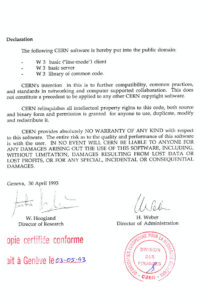And yet, the most shocking part of the decision was that it wasn’t shocking at all.
Berners-Lee and his team at CERN, together with web pioneers from around the world, had a lot of decisions to make early on. Because the web is globally distributed and publicly accessible, those decisions could rarely be reversed. A lot of time was given to the formation of syntax, the language of protocols and specifications, the design and details of the browser, and dozens of other things. The early web community was making decisions each and every day, one more deliberate and precise than the next.
In 1999, Tim Berners-Lee published his own history building the web in a book, titled Weaving the Web in which he describes many of these decisions at great length. But CERN’s decision to enter the web into the public domain gets only a few paragraphs. There were some discussions, and there was a chance that maybe it didn’t happen, but all in all it happened relatively quickly. It was a product of timing and position.
For a while, in the early 90’s, the web was in competition with Gopher, an alternative Internet-backed protocol developed at the University of Minnesota, and named for the school’s mascot. Gopher shared some philosophical preferences with the web, but it was, in practice, something entirely different. Gopher was hierarchical by design, a stark contrast to the sprawling, nonhierarchic hyperlink of the web. Gopher also put resources behind search and design of sites years before technologies like Google and browsers like Netscape would do the same for the web.
As a result, it was pretty popular. Maybe more so than the web. But there’s a reason we don’t hear much about Gopher these days.
In February of 1993, the University of Minnesota made an announcement. In specific commercial usage of the protocol, they would be charging licensing fees. Not large fees, and not in all cases. But, in some small way, they would be restricting access.
Overnight, sentiment shifted. Internet users took to BBS boards and mailing lists to express outrage about Gopher’s decision. IBM declared that they wouldn’t support internally any protocol with restrictive licensing. The world began searching for alternatives.
Back at CERN, Berners-Lee had just the thing. He was already in early conversations with CERN about an open-source license for the platform. But after the Gopher announcement, he changed that request. He didn’t want any restrictions at all, no rights or attachments at all. The web needed to be free. Truly free.
CERN had some advantages that the University of Minnesota didn’t. Financially there wasn’t a ton to be gained from maintaining such a massive technology so far outside of their core competency (they’re a particle physics lab after all). And in terms of scale, they’re operating an order of magnitude or two above any research wing of a university. So a technology like the web, as it big as it would become, wasn’t as important to their organization or its mission. Besides, they saw what happened at Gopher and didn’t want to deal with that kind of fallout.
But also, and this is important to mention, they believed in the web and in Berners-Lee. The folks making these decisions understood its potential and wanted the web to flourish. This wasn’t a decision driven by profit. It was a generous and enthusiastic vote of confidence in the global ambitions of the web.
And so, on April 30 1995, with a half-page document and a few signatures, CERN made it official. Nobody owned the web, and the web wasn’t licensed. It was simply a part of the world, for anybody to use, distribute, or modify. It looked like this:

Recalling that decision ten years later, Tim Berners-Lee recorded a short message about the continued openness of the web:
If we did not have that document from CERN, we would not have the web. But the web’s not done.
And it’s still not done.

KUDOS to https://thehistoryoftheweb.com/postscript/the-webs-most-important-decision/